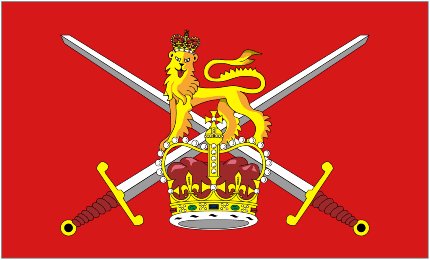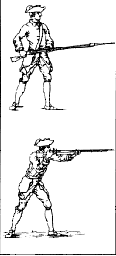
foreword | Historical Narratives | Resources | Links | Contact
7TH REGIMENT OF FOOT
History is a record of humankind in war and peace.
 |
|
Flag of the British Army |
During the War of 1812, British regulars served as a major force in what Britain considered a minor conflict. As their casualty figures indicated, they did the lion's share of the fighting in British North America and British officers provided most of the military leadership. Over the years the strength and number of British regiments here reflected the changing status in Anglo-American relations. As tensions increased between Britain and the United States, so did the strength in regimental forces. After 1790 their relationship worsened and redcoat reinforcements included the 7th Regiment of Foot or the Royal English Fusiliers.
The Royal Fusiliers, which on one occasion garrisoned the Tower of London, was a crack corps never in want of volunteers. The regiment served at Montreal and along the frontier during the American Revolution. Later it was located in Gibraltar from where in 1790 it transferred to Quebec and by 1792 ten companies were garrisoned there. The Fusiliers also served at Halifax from 1796 till 1799. During this period the regiment was commanded by the father of Queen Victoria, His Royal Highness Prince Edward, afterwards Duke of Kent. He was a maniacal martinet whose Hanoverian demand for discipline, smartness and polish was brutally enforced with the cat-o'-nine-tails.
The Fusiliers were originally armed with a light flintlock musket called a fusil, They served as marines during the early years of the Revolution and saw a good deal of action on the Great Lakes. They also served at in-land campaigns under British Generals Clinton and Cornwallis.
The 7th Regiment fought in Quebec for much of the War of 1812. Later the Royal Fusiliers were transferred south where they took part on January 8th, 1815, in the Battle of New Orleans, the ultimate example of the waste of war. The peace treaty ending the war of 1812 had been signed two weeks earlier on December 24, 1814. Travel time was only as fast as a man or a horse could run or the wind blew and so the news from Europe travelled slowly and on the day of the bloody battle, the treaty document was in the dispatch case of an American official heading for home on the high seas.
 |
This battle involved one of the most senseless manoeuvres in the history of British warfare. Its commander-in-chief, Sir Edward Pakenham, was the brother-in-law of the Duke of Wellington. While Packenham served with distinction under Wellington, he failed when given an independent command. When he arrived at the British camp, his first impression was that the force was in a bad position and should relocate. Other officers persuaded him that a determined advance with the bayonet would drive the American militia off. Meanwhile the Americans had reinforced their ramparts and Packenham's men made a frontal assault on an entrenched American force well-protected by earthworks. The collection of Creoles and militiamen from Kentucky, Louisiana and Tennessee were led by General Andrew Jackson.
Under fire from the flank as well as front, the scarlet-coated troops buckled before the American fusillade that rippled through their ranks. A private named Henry Oxburn of the 7th crouching as he fled from the withering fire received a ball above the hip which ran right up his body to finish near his eye. It was successfully extracted and he rejoined his regiment, "much altered in shape, but not fit for further service."
When Pakenham launched a frontal assault on the American breastworks, the lead battalion which was carrying ladders, came under fire. Some dropped their burdens to shoot back, while others scampered to the rear. Pakenham, who had had his horse shot out from under him, immediately mounted his aide's black pony and tried to stop them by shouting, "For shame! Recollect you are British soldiers," only to fall himself after receiving a third mortal wound. Packenham's successor ordered the campaign abandoned.
A number of the British troops who died that day had recently completed their seven years' of service, and were due for discharge. More than one quarter of the 8,000 regulars were cut down by highly skilled American sharpshooters. During the same battle only eight Americans were killed and thirteen wounded. The devastating defeat and retreat of the trained British army by a motely mix of militiamen convinced the Americans that they had beaten Britain into submission and so had won the War of 1812, since news of the peace treaty ending that conflice had not arrived in Washington until more than a month after the half-hour battle. The victory served to glorify the name of Andrew Jackson and he rode his win to the Whitehouse and Old Hickory, his nickname, became the llth president in 1828.
Following the 7th Regiment's return to England, it was ordered to Belgium, where it landed at Ostend on the very afternoon of the Battle of Waterloo. Its superb battalion of 1200 bayonets joined other regiments as the army of occupation in France until 1818.
 |
Drills were a never-ending routine for the redcoats. Above are two key positions for infantrymen as illustrated in a British drill manual: charge and fire. Parade-ground tactics involved marching, forming into columns and squares and changing directions. The length of the troops' paces had to be exact and precise, and when well done gave them a bold and imposing air. It also made it possible to determine how long it would take to travel a certain distance. Troops usually moved in columns to promote control, and fought in line to maximize firepower. After delivering two or three crashing volleys, the troops charged with the bayonet. This required superb discipline and fancy footwork.
Deploying from column of march to line of battle was a complex procedure, which required careful attention to maintaining the distances between parallel columns, so that when each column wheeled through ninety degrees, it did so without large gaps or confusing overlaps. Wheeling required those men on the inner flank to mark time (march on the spot), while those on the outer flank stepped out briskly. This manoeuvre called for a very high standard of foot drill. The line eventually triumphed over the column with the invention of the percussion cap in 1822.
Drill and discipline were required to defeat the enemy by firepower, especially their cavalry which could bowl over a thin line of troops by speed and shock alone. The rigorous and extensive training were intended to maintain discipline in the face of a steady enemy. Some authorities felt that five years drilling was needed to turn a recruit into a disciplined soldier. Fusiliers were armed with sword, bayonet, and the light, snaphance musket with a barrel 3 feet 6 inches long. Gun drill included training to load and fire the short-range, inaccurate musket two or three times a minute while standing in ranks shoulder to shoulder. With this musket a round paper cartridge of gunpowder was inserted down the muzzle, followed by a lead ball, then both were forced down the barrel of the musket with a ramrod, a steel rod about the length of the barrel, which was fastened underneath the musket for easy access. It was also used to roast salt meat over a campfire.
Before inserting this cartridge into the muzzle, the soldier bit off the top with his teeth and dropped some powder into the flash pan near the musket trigger. Physical tests for the army required sufficient teeth in the upper and lower jaws to bite this cartridge quickly. In the hammer of the musket was fixed a piece of flint, which struck a piece of steel near the flash-pan when the trigger was pulled. Pulling the trigger threw up the cover of the pan, and sent a spark into the powder, causing it to ignite, explode the cartridge ane send the ball down the barrel. "A flash in the pan," an expression still used today is derived from pulling the trigger and having the powder flash without igniting the cartridge. Drill was not always painless for faces were specked and stained by the course powder from the muskets belching flame and black smoke. Ears suffered from the deafening volleys and eyes smarted from the burning smoke.
In Canada sniper fire and forest fighting limited opportunities for the long red line to display its steady discipline. Light infantrymen were in greater demand. They fought in the hit-and-run manner of Native warriors and backwoodsmen. Soldiers were over-dressed and uncomfortable for parade-ground battle. Tight shoes and gaiters pinched, as did the tight-fitting red uniform whose stiff leather stock at the throat kept the head erect. Although its facings (collar, cuffs, and lapels) were originally dark blue, they were later changed to yellow. Regimental distinctions like the facings were specified by royal warrant in 1768. Breeches and stocking were grey and the tall, cloth hat was yellow.
Today the brightly coloured uniforms with gold and silver trim and tall, plumed hats seem weird wear for war. However, muskets had a limited range and accuracy and camouflage were not critical on the open battlefield where soldiers shot in salvoes. The first necessity was to be instantly recognizable and for this reason the Duke of Wellington demanded that the uniforms be as different from the enemies' as possible. This was accomplished by colour and in various other ways including the placement of plumes at the side of cap rather than at the front in the French style. Bright colours and elaborate accessories were also intended to make the fighter look impressive. Epaulettes and white cross belts served to exaggerate height and breadth making the soldiers appear more awesome. Uniforms were also meant to make the wearer proud. Facings, lace, ribbons, belts, buttons - any token, trifle or label associated with former glories - all combined to foster fierce regimental pride. To wear the uniform was to uphold its reputation for bravery and discipline.
Tradition and honour were reflected in a regiment's Colours. For loyal service and conspicuous valour, regiments were awarded battle honours which bore the name of the place where the battle took place. This name was emblazoned on the Colours which the regiment carried proudly into battle. Battle honours of the 7th Regiment included the Peninsular War, the Pyrenees and Sevastopol, where the Fusiliers furnished more men for the Crimean War than any other regiment.
Copyright © 2013 Website Administrator